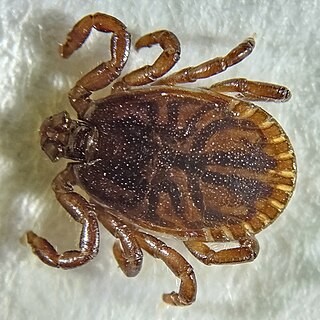Top Qs
Timeline
Chat
Perspective
Haemaphysalis concinna
Species of tick From Wikipedia, the free encyclopedia
Remove ads
Haemaphysalis concinna is a common rodent tick species that originally predominantly occurred in Russia and Eastern Europe,[1] but is also known from Japan, China, Germany and France.[2]
It is known to act as a vector of tickborne disease.[1]
Remove ads
Description
Females reach a length of three to four mm, but can grow up to ten mm when engorged; males are about three mm long. An unfed nymph is under two mm long. There are more males than females.[2]
Distribution, ecology
The tick can be found in the warm temperate climate zone of deciduous and mixed forests across Europe and Asia. It prefers moist habitats lake shores or river banks.[3] In China, it has been found in northeastern regions including Liaoning, Jilin, Heilongjiang, and Inner Mongolia.[4]
Physiology
All three stages target different hosts, the eggs are laid on the ground. They mate on their host around April.[2]
Nymphs and larvae feed on small mammals such as rodents or hedgehogs, or on birds, reptiles, and humans. Adults prefer larger mammals, ranging from cats to horses, again including humans.[2]
Diseases
H. concinna can act as a vector for Francisella tularensis (causing tularaemia), Rickettsia sibirica (Siberian tick typhus), Rickettsia heilongjiangensis (Far-Eastern spotted fever), Virus of Russian spring-summer encephalitis (RSSE) and tick-borne encephalitis (TBE).[2] It is a likely vector of Wetland virus.[3]
References
External links
Wikiwand - on
Seamless Wikipedia browsing. On steroids.
Remove ads

